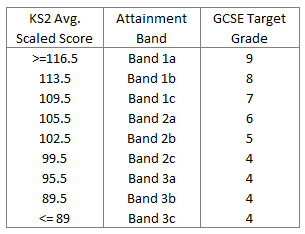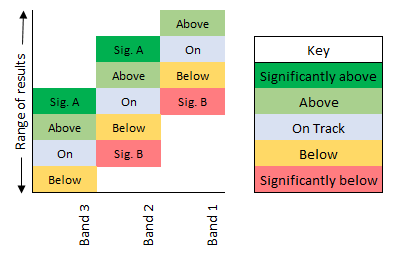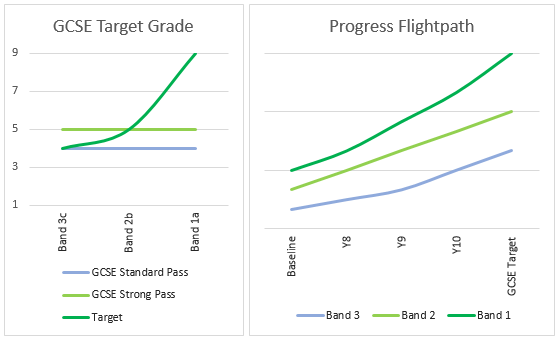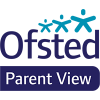Assessment and Reporting
Assessment & Reporting at Leytonstone School
At Leytonstone School, we have high expectations for our pupils. Our assessment models for both KS3 and KS4 utilise the baseline testing of pupils to ensure that targets and expectations of pupils are reflective of each pupils’ potential attainment. Below is a guide to our reporting systems through KS3 (Years 7-9) into KS4 (Year 10-11). We hope that families will find our reports a useful insight into the development of their child during their time at our school.
Bands are set
Most pupils will come to Leytonstone School with KS2 test results which create the baseline for which all future progress is assessed, both internally and nationally. Pupils without official KS2 results may undertake CATS (Cognitive Ability Tests) or teacher lead assessments to provide a relative baseline score.
Using the Department for Education guidance for KS4 accountability measures, we issue all pupils an attainment band using pupil baseline data, as seen in the table below.

This attainment band is also used to create a prospective flightpath through KS3 learning into GCSE target grades that are both ambitious and based on national outcomes for pupils of similar prior attainment thresholds. It is our aim for all pupils, regardless of starting point, to aim for above expected progress, with a minimum of a standard pass (Grade 4) at GCSE or equivalent.
|
|
Subject Assessment
Formal assessments take place in all subjects across the curriculum throughout the academic year. The frequency of tests may vary and so, for KS3, the average percentage outcomes of any assessments taken that term will be calculated at the end of each academic report window. In KS4, teachers will use a range of in-class assessments, practice papers and GCSE exam questions to assess their pupils.
Benchmarking
For KS3 pupils, in order to compare the performance of pupils against their baseline, we need to find a relative expected assessment range. We do this by setting thresholds in each subject to proportionally represent the prior ability bands within each cohort. This is a similar approach to how GCSE grade boundaries are set following the exams window every year.

Once thresholds are set, each pupil’s score is compared to their expected outcome. This is similar to how a school’s Progress 8 score is calculated by the Department of Education each year, comparing the GCSE results of similar pupils nationally against their KS2 data. When reviewing this data, it is important to remember that pupils achieving below the expected threshold does not equal failure, but that the pupil’s most recent attainment score is not within their fullest potential. In order to achieve significantly below or above their expected pathway, pupils must achieve a whole band above their flightpath (e.g. Band 2b pupil obtaining a score of a Band 1b pupil).
In KS4, pupils will receive a current GCSE grade in comparison to their GCSE Target Grade. The current grades are based on what pupils have achieved in their most recent assessments, as a snapshot on their journey towards their final outcome, and progress will be expected. We anticipate most pupils, with good effort, behaviour and attendance to school, could improve by at least one to two grades between Year 10 Term 1 and the end of Year 11, but outcomes will always be reflective of each pupil’s commitment to their studies.
Progress is reported
In KS3 and 4, we feedback to families through termly reports. However, the success of pupils does not rely on test scores alone. Pupil effort (attitude to learning), engagement with home learning tasks (Cover 2 Cover), attendance, punctuality and behaviour all play a part in pupil outcomes; as such, a comprehensive overview of each pupil is provided at the end of each term, as seen in the examples below.
Example KS3 Report
Example KS4 Report
Outcomes are reviewed
Following publication, pupils are given time to reflect on their report in an extended tutor time session. Pupils, along with support from form tutors, are encouraged to self-evaluate their academic progress and highlight what is going well, identify areas for improvement and set targets for the term ahead. Likewise, departments will review cohort results and identify pupils who may be in need of further support and intervention.
By providing families and pupils with regular, holistic updates on each child’s progress, we hope to work together to give all pupils the best possible chance at achieving their full potential at GCSE.
Please see the Progress and Assessment at KS3 presentation below - Deputy Head Teacher - Mr R Wanza.




